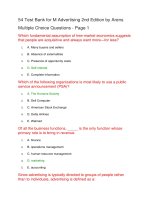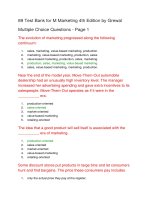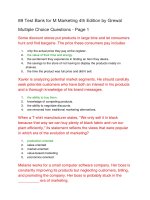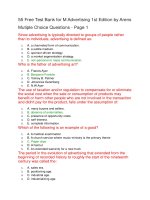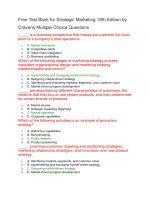59 test bank for employee benefits 5th edition by
Bạn đang xem bản rút gọn của tài liệu. Xem và tải ngay bản đầy đủ của tài liệu tại đây (75.09 KB, 13 trang )
Test Bank for Employee Benefits 5th Edition by
34 Test Bank for Employee Benefits 5th Edition by
Martocchio True – False Questions
25 Test Bank for Employee Benefits 5th Edition by
Martocchio Multiple Choice Questions
The Social Security Act of 1935 set up which two programs? (The Social
Security Act of 1935)
1.
A. Retirement income & unemployment insurance
2.
B. Medicare & disability insurance
3.
C. Disability insurance & retirement income
4.
D. Unemployment insurance & Medicare
Which of the following are considered the five core compensation
elements? (Adjustments to Core Compensation)
1.
A. COLAs, seniority pay, merit pay, incentive pay, person-focused pay
2.
B. Merit pay, seniority pay, COLAs, incentive pay, base pay
3.
C. Seniority pay, person-focused pay, incentive pay, base pay, COLAs
4.
D. Base pay, person-focused pay, merit pay, incentive pay, seniority pay
Information for strategic benefits planning comes from these two
environments. (Information Used in Strategic Benefit Planning)
1.
A. External company & internal market
2.
B. External market & internal company
3.
C. Internal market & external market
4.
D. Internal company & external company
Which two make up the internal environmental factors? (Internal
Environment)
1.
A. Labor force demographics, governmental regulations
2.
B. Mergers and acquisitions, labor force demographics
3.
C. Governmental regulations, collective bargaining agreements
4.
D. Workforce demographics, collective bargaining agreements
Which three are the three fundamental roles that characterize
discretionary benefits? (Discretionary Benefits)
1.
A. Protection programs, paid time-off, retirement programs
2.
B. Protection programs, paid time-off, accommodation and enhancement
programs
3.
C. Paid time-off, accommodation and enhancement programs, retirement
programs
4.
D. Retirement programs, protection programs and accommodation and
enhancement programs
Which two are the possible approaches that can be used in strategic
benefits planning? (Approaches to Strategic Benefit Planning)
1.
A. Backing-out & top-down
2.
B. Top-down &backing -in
3.
C. Backing-up & top-in
4.
D. Backing-down & top-in
What is another name for a pay-for-knowledge plan? (Adjustments to Core
Compensation)
1.
A. Merit-pay
2.
B. Person-focused pay
3.
C. Seniority-pay
4.
D. Incentive-pay
Companies can generally choose from which four programs for financing
their discretionary benefits plans. (Basic Design Considerations for
Discretionary Benefits)
1.
A. Noncontributory, contributory, employee-financed, a combination of the other
three
2.
B. Managed care, contributory, employee-financed, a combination of the other
three
3.
C. Employee-financed, contributory , managed care, a combination of the other
three
4.
D. Managed care, contributory, employee-financed, noncontributory
Commission payments are examples of which type of core compensation
package? (Adjustments to Core Compensation)
1.
A. Incentive pay
2.
B. Merit pay
3.
C. Person-focused pay
4.
D. Seniority pay
Discretionary benefits can be categorized into programs that
(Discretionary Benefits)
1.
2.
A. Protect health and income, provide job security, provide accommodation and
enhancement benefits
B. Provide job security, protect health and income, allow for paid time-off
3.
C. Protect health and income, allow for paid time-off, provide accommodation and
enhancement benefits
4.
D. Provide job security, allow for paid time-off, provide accommodation and
enhancement benefits
Flexible benefits allow employees to do which of the following? (Basic
Design Considerations for Discretionary Benefits)
1.
A. Choose which benefits they want and at what level
2.
B. Only choose the level of benefits they want
3.
C. Only choose which benefits they want
4.
D. Choose whether they want all base pay or pay and benefits
The Family and Medical Leave Act (FMLA) permits employees which of the
following? (The Family and Medical Leave Act of 1993)
1.
A. 12 work weeks of paid leave during any 12-month period
2.
B. 10 work weeks of paid leave during any 12-month period
3.
C. 12 work weeks of unpaid leave during any 12-month period
4.
D. 10 work weeks of unpaid leave during any 12-month period
These two federal laws form the basis for legally required benefits.
(Legally Required Benefits)
1.
A. Social Security Act & Civil Rights Act
2.
B. Family and Medical Leave Act & Civil Rights Act
3.
C. Social Security Act & Family and Medical Leave Act
4.
D. Equal Employment Act & Social Security Act
When the employee bears the entire costs of discretionary benefits it is
referred to as which type of financing? (Basic Design Considerations for
Discretionary Benefits)
1.
A. Noncontributory
2.
B. Contributory
3.
C. Employee-financed
4.
D. Employee-focused
Which is the following is NOT the element of discretionary benefits?
(Discretionary Benefits)
1.
A. Retirement plans
2.
B. Workers’ compensation
3.
C. Health insurance
4.
D. Paid vacations
Which of the following factors are used for strategic benefits planning?
(External Environment)
1.
A. Government regulations
2.
B. Economic conditions
3.
C. Labor force changes
4.
D. All of the above
In which social context were workers' compensation laws enacted? (State
Compulsory Disability Laws (Workers’ Compensation))
1.
A. Post Depression
2.
B. Post WWII
3.
C. Industrial expansion in the early 1900s
4.
D. Turn of the 20th century
What are the four main classes of health insurance programs that
employers have to choose from to offer its' employees? (Health Protection
Programs)
1.
A. Fee-for-service plans, managed care plans, point-of-service plans, consumerdriven plans
2.
B. Consumer-driven plans, point-of-service plans, managed care plans, fee-forservice plans, person-focused plans
3.
C. Fee-for-service plans, person-focused plans, point-of-service plans, point-ofservice plans
4.
D. Point-of-service plans, consumer-driven plans, managed care plans, personfocused plans
Which of the following is not a fundamental employee goal? (Legal and
Regulatory Influences on Discretionary Benefits Practices)
1.
A. High wages
2.
B. Leadership
3.
C. Job security
4.
D. Safe working conditions
Which of the following are the three main types of retirement programs
that companies can offer? (Income Protection Programs)
1.
A. Employee-financed plans, defined benefits plans, hybrid plans
2.
B. Hybrid plans defined contribution plans employee-financed plans
3.
C. Defined contribution plans, employee-financed plans, defined benefits plans
4.
D. Defined contribution plans, defined benefits plans, hybrid plans
Which of the following is not an example of features of a benefit plan?
(Basic Design Considerations for Discretionary Benefits)
1.
A. Flexible benefits
2.
B. Eligibility
3.
C. Waiting period
4.
D. Employee choice
In 2011, about how many million persons were employed by private-sector
companies? (Legal and Regulatory Influences on Discretionary Benefits
Practices)
1.
A. 90 million
2.
B. 109 million
3.
C. 118 million
4.
D. 125 million
In 2011, what was the average total employer compensation costs for
private industry workers? (Employer Costs for Compensation and
Benefits)
1.
A. $30.11
2.
B. $20.91
3.
C. $35.50
4.
D. 28.24
Employer choice of discretionary benefits does not depend on:
(Government Regulation of Employee Benefits)
1.
A. Economic considerations
2.
B. Adequacy of legally required benefits
3.
C. Employee expectations
4.
D. Government mandates
Which is the following is NOT the reason for companies to adopt various
benefits plans? (Defining and Exploring Employee Benefits)
1.
A. Government regulation/mandates
2.
B. Favorable tax treatments
3.
C. Attracting and retaining best employees
4.
D. Reducing labor cost
34 Free Test Bank for Employee Benefits 5th Edition
by Martocchio True - False Questions
The Social Security Act was enacted due to the effects of WWII. (The
Social Security Act of 1935)
1.
True
2.
False
Unemployment insurance is funded solely by the Federal Unemployment
Tax Act (FUTA). (Government Regulation of Employee Benefits)
1.
True
2.
False
Protection programs provide health benefits. (Health Protection
Programs)
1.
True
2.
False
Compensation levels are established based on employee age.
(Adjustments to Core Compensation)
1.
True
2.
False
Workers' compensation insurance programs, run by the federal
government, are designed to cover employee expenses incurred in workrelated accidents and injuries. (State Compulsory Disability Laws
(Workers’ Compensation))
1.
True
2.
False
Workers' compensation laws are state laws. (State Compulsory Disability
Laws (Workers’ Compensation))
1.
True
2.
False
Core compensation is another name for monetary rewards. (Employee
Benefits in the Total Compensation Scheme)
1.
True
2.
False
Since the 1940s, companies have expanded their discretionary benefits as
an alternative to wage increase or as a motivational tool. (Origins of
Employee Benefits)
1.
True
2.
False
Flexible work schedules are considered part of accommodation and
enhancement benefits packages. (Defining Employee Benefits)
1.
True
2.
False
Benefits are a central strategy in attracting and retaining desired
employees. (Basic Strategic Planning Concepts)
1.
True
2.
False
Employees are most likely to endorse benefits that fulfill their needs.
(Basic Design Considerations for Discretionary Benefits)
1.
True
2.
False
Strategic decisions support the fulfillment of tactical decisions. (Basic
Strategic Planning Concepts)
1.
True
2.
False
In financing discretionary benefits, employers always pay the total cost
incurred. (Basic Design Considerations for Discretionary Benefits)
1.
True
2.
False
Vacations are a type of accommodation benefit. (Paid Time-Off)
1.
True
2.
False
Defined benefits plans, defined contribution plans and hybrid plans are
types of health insurance funding plans. (Income Protection Programs)
1.
True
2.
False
Employer-sponsored disability insurance is less encompassing than
workers’ compensation. (Disability Insurance)
1.
True
2.
False
Cost-of-living adjustments (COLAs) are based on changes in prices as
indexed by the consumer price index. (Adjustments to Core
Compensation)
1.
True
2.
False
Life insurance programs protect employees' families in the event of
untimely illness. (Income Protection Programs)
1.
True
2.
False
Cafeteria plans enable employees to choose from among a set of benefits
and different levels of these benefits. (Basic Design Considerations for
Discretionary Benefits)
1.
True
2.
False
The Federal Insurance Contributions Act (FICA) helps support the OldAge, Survivor, and Disability Insurance (OASDI). (Government Regulation
of Employee Benefits)
1.
True
2.
False
Merit-pay rewards employees according to their job performance.
(Adjustments to Core Compensation)
1.
True
2.
False
Benefits are defined as compensation that includes wages and salary as
well as other services. (Defining Employee Benefits)
1.
True
2.
False
ERISA does not apply to public sector retirement plans. (Legal and
Regulatory Influences on Discretionary Benefits Practices)
1.
True
2.
False
Employees' knowledge and skills are said to generate human capital for
firms and are the basis for incentive-pay. (Adjustments to Core
Competition)
1.
True
2.
False
The Fair Labor Standards Act first legitimized bargaining for employee
benefits. (Origins of Employee Benefits)
1.
True
2.
False
Total compensation represents both monetary and nonmonetary rewards.
(Employee Benefits in the Total Compensation Scheme)
1.
True
2.
False
Strategic benefit plans emphasize short-term changes in how a company's
benefit plan operates. (Basic Strategic Planning Concepts)
1.
True
2.
False
Health insurance is a legally required benefit for all private sector
employers? (Health Protection Programs)
1.
True
2.
False
Incentive-pay is a permanent increase of compensation based on
individual goal achievement. (Adjustments to Core Compensation)
1.
True
2.
False
Nonmonetary compensation includes protection programs, paid time off
and services. (Employee Benefits in the Total Compensation Scheme)
1.
True
2.
False
The top-down approach to strategic benefits planning is a reactive
process that evaluates the benefits program only after problems arise.
(Approaches to Strategic Benefit Planning)
1.
True
2.
False
The existence of labor union has limited the use of welfare practices by
companies. (Origins of Employee Benefits)
1.
True
2.
False
Union workers cannot negotiate paid time off benefits. (Paid Time-Off)
1.
True
2.
False
Incentive-pay rewards employees for completely attaining predetermined
work objectives. (Adjustments to Core Compensation)
1.
True
2.
False
